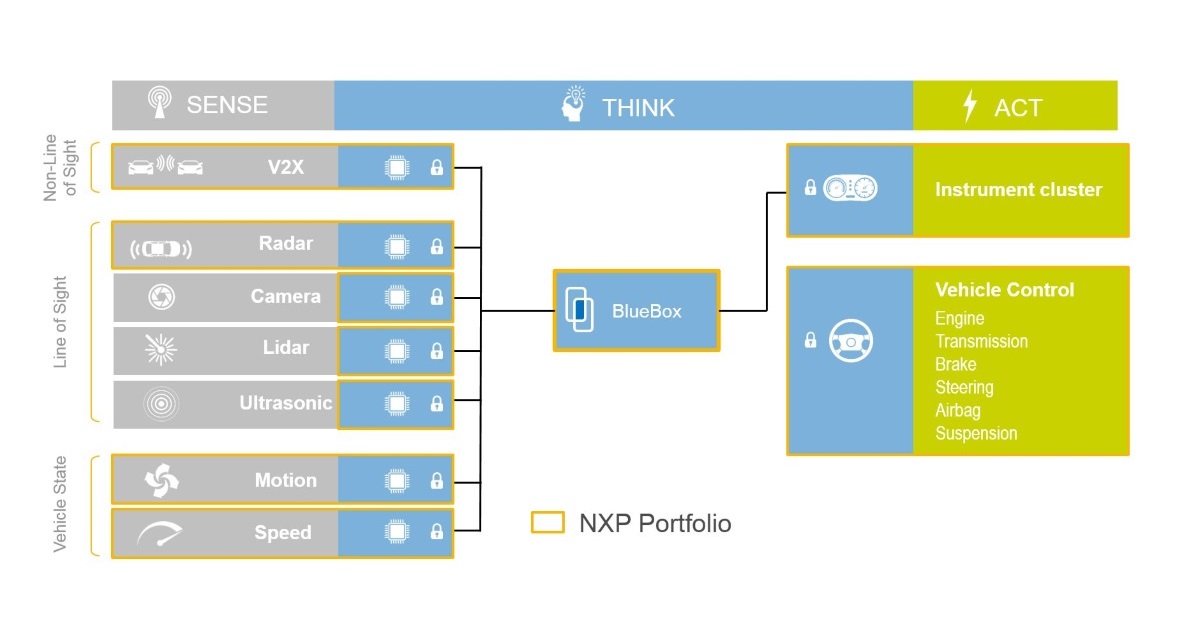 恩智浦的BlueBox系统可以收集来自多个传感器的数据,并综合这些输入从而做出安全决定。
恩智浦的BlueBox系统可以收集来自多个传感器的数据,并综合这些输入从而做出安全决定。
如今,芯片供应商也在抓紧行动,便利自动驾驶汽车的到来。最近,恩智浦半导体公司(NXP Semiconductors)推出了一款BlueBox安全控制器,可承担传感器融合、数据分析及完成复杂联网等任务。
据悉,恩智浦半导体去年成功收购飞思卡尔(Freescale),从而成为世界上最大的汽车半导体供应商,而后者在为恩智浦的系统供应所需的硅材料。恩智浦推出的新模块表明,芯片生产商已经逐步开始在系统方面进行布局。去年,瑞萨公司(Renesas)也与多家合作伙伴组队,并利用后者的传感器等组件强化公司的自动驾驶平台。
具体来说,安全系统能够做出制动和转向的决定,从而为自动驾驶的到来铺平道路,而中央控制器则可收集来自多个传感器的输入,并将这些信息整合起来进行综合分析。这些控制器通常可以分辨车辆、行人和其他物体,然后判断这些对象是否会影响车辆的行驶,以及可能带来怎样的影响。
恩智浦的BlueBox配备了2个处理器,可以整合不同渠道的数据输入,并做出综合判断。其中,网络设备可以承担通信任务,而安全控制器则会整合来自摄像头、雷达、激光雷达及车-车通信系统的数据输入。系统的集中控制器配备了一块RAM内存,功率需求相当低。
“BlueBox的处理速度高达90,000 DMIPS(每秒百万条指令),而功耗却不到40W,绝不会超出车辆的功率分配,”恩智浦汽车营销经理Mark O’Donnell表示,“如今,汽车中的各种系统都要用电,这是一个大问题。”
BlueBox安全控制器配备了四核微处理器和硬件加速器。网络芯片则比较大,共有八核。事实上,无论是计算能力的提升,还是向以太网的转型均凸显了一个现实:未来的中央计算机需要应对来自多个传感器的输入,处理海量数据。
“我们必须改变现有的网络架构,从CAN和LIN转向以太网,”恩智浦汽车业务CTO Lars Reger表示,“在一些高端车型中,车内电缆的重量比我还重,而以太网可以削减这部分重量。此外,我们还需要采用分域架构,这样一旦信息娱乐系统遭到攻击,威胁也不会蔓延至其他系统,而以太网就能够帮我们实现这种架构,还允许我们增加更多的安全系统和网关。”
BLUEBOX是一个基于Linux的开放平台。该系统经过专门设计,厂商和一级供应商的定制非常容易。Reger指出,厂商希望亲自编写自己的软件,而不是依赖于神经网络和“深度学习”等允许车辆随着时间自己开发出一些规则的功能。
“车辆就算拥有与人类相仿的认知能力也并没什么用,它不需要知道监测到的车辆是新车还是旧车,监测到的行人是男人还是女人。”Reger表示,“车辆需要的是一个高度可靠的判断系统,能够监测物体并进行分类。”
Reger还强调,法律环境将在自动系统和主动安全系统的逐渐推进中发挥关键作用。
Reger表示,“如果汽车生产商必须在法庭上解释为什么车辆要左转而不是右转,他们肯定不能说这是车辆的神经网络做出的决定。”
作者:Terry Costlow
来源:SAE汽车工程杂志
翻译:SAE 中国办公室
著作权声明:如您希望在微信公众号之外的平台上转发SAE的相关原创稿件,请您务必事先与SAE取得联系。
New NXP system drives sensor fusion for autonomous vehicles
Silicon suppliers are stepping up to help facilitate progress in the road to autonomous driving. NXP Semiconductors has unveiled its BlueBox, which handles sensor fusion, analysis and complex networking.
NXP, which became the largest automotive semiconductor supplier last year by acquiring Freescale, provides all the silicon in the system. The module underscores chipmakers’ growing focus on systems. Last year, Renesas teamed up with a number of partners whose sensors and other components augment its autonomous driving platform.
As safety systems that make decisions on braking and steering pave the way for more autonomous driving, central controllers collect input from multiple sensors and stitch it together so it can be analyzed. These controllers will typically classify vehicles, pedestrians and other objects, then determine whether and how these objects impact the vehicle’s movement.
NXP’s BlueBox utilizes two main processors to fuse inputs and make decisions. A networking device handles communications while a safety controller combines inputs from cameras, radar, lidar and vehicle-to-vehicle communications. The centralized controller, which includes significant RAM, has fairly low power requirements.
“The box runs at 90,000 DMIPS (million instructions per second) and draws less than 40W, which fits the power budget of vehicles,” said Mark O’Donnell, the company's Automotive Marketing Manager. “Everything on the vehicle these days is power hungry, so that’s a big concern.”
The safety controller has four microprocessor cores and hardware accelerators. The networking chip is larger, with eight cores. That level of computing power and a shift to Ethernet highlight the huge volumes of data that will flow into a centralized computer that combines several sensor inputs.
“We’ve got to change the networking architecture, going from CAN and LIN to Ethernet,” said Lars Reger, NXP's Automotive CTO. “On high-end cars, the cabling weighs more than I do, Ethernet can help reduce that weight. We need domain architectures so if the infotainment branch is attacked, it doesn’t go any further. Ethernet enables this architecture and includes the ability to add security and gateways.”
The BlueBox is an open platform with Linux software. It’s designed for easy customization by OEMs and Tier 1s. Reger noted that OEMs will want to write their own software rather than relying on neural networks and 'deep learning,' which let the car develop some of its own rules over time.
“It does not help if the car has the same level of recognition that a person has; it’s not important to know whether a car is old or new or whether a pedestrian is male or female,” Reger said. “Vehicles just need a highly reliable and deterministic system that does object detection and object classification.”
He also addressed the legal climate that will play a critical role in the eventual rollout of autonomous and active safety systems.
“If a carmaker in court needs to defend why a car turned left instead of right, they don’t want to explain that a neural network made the decision,” Reger said.
Author: Terry Costlow
Source: SAE Automotive Engineering Magazine
等级
打分
- 2分
- 4分
- 6分
- 8分
- 10分
平均分
- 作者:Terry Costlow
- 行业:汽车
- 主题:安全性人体工程学/人因工程学
